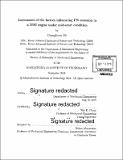| dc.contributor.advisor | Wai K. Cheng. | en_US |
| dc.contributor.author | Oh, Changhoon | en_US |
| dc.contributor.other | Massachusetts Institute of Technology. Department of Mechanical Engineering. | en_US |
| dc.date.accessioned | 2017-01-30T19:18:11Z | |
| dc.date.available | 2017-01-30T19:18:11Z | |
| dc.date.copyright | 2016 | en_US |
| dc.date.issued | 2016 | en_US |
| dc.identifier.uri | http://hdl.handle.net/1721.1/106786 | |
| dc.description | Thesis: Ph. D., Massachusetts Institute of Technology, Department of Mechanical Engineering, 2016. | en_US |
| dc.description | Cataloged from PDF version of thesis. | en_US |
| dc.description | Includes bibliographical references (pages 155-160). | en_US |
| dc.description.abstract | Due to their advantages in higher fuel efficiency and torque compared to conventional port fuel injection (PFI) engines, direct injection spark ignition (DISI) engines have become dominant in gasoline-fueled engines. However, DISI engines have a significant drawback in particulate matter (PM) emission: the PM emission of DISI engines is at least an order of magnitude higher than that of PFI engines. The objective of this study is to investigate PM emission in DISI engines, mainly focusing on particulate number (PN) emission. The study aims to assess, respectively, the plausible PM formation mechanisms: non-fuel originated sources (e.g., lubricant), flame propagation in rich mixture and the pyrolysis of the vapor from liquid fuel film. Through a series of experiments, it has been found that non-fuel contribution is less important than the other two mechanisms. For all operating conditions, the absolute amount of the non-fuel contribution is much smaller than the total emission. In case of PM generated by flame propagation in rich mixture, there is a threshold air-fuel equivalence ratio below which PM starts to form rapidly. The threshold is influenced by the combustion temperature. PM starts to form at lower equivalence ratio when the combustion temperature was lower. Contrary to the PM generated from flame propagation in fuel-rich mixture case, that from the liquid fuel film is suppressed by lowering the combustion temperature. Transmission electron microscopy (TEM) imaging shows that the sizes of primary particles and agglomerated particles become larger as engine load increases, but particulates from different mechanisms have different morphology. | en_US |
| dc.description.statementofresponsibility | by Changhoon Oh. | en_US |
| dc.format.extent | 162 pages | en_US |
| dc.language.iso | eng | en_US |
| dc.publisher | Massachusetts Institute of Technology | en_US |
| dc.rights | MIT theses are protected by copyright. They may be viewed, downloaded, or printed from this source but further reproduction or distribution in any format is prohibited without written permission. | en_US |
| dc.rights.uri | http://dspace.mit.edu/handle/1721.1/7582 | en_US |
| dc.subject | Mechanical Engineering. | en_US |
| dc.title | Assessment of the factors influencing PN emission in a DISI engine under cold-start condition | en_US |
| dc.title.alternative | Assessment of the factors influencing particulate number emission in a direct injection spark ignition engine under cold-start condition | en_US |
| dc.type | Thesis | en_US |
| dc.description.degree | Ph. D. | en_US |
| dc.contributor.department | Massachusetts Institute of Technology. Department of Mechanical Engineering | |
| dc.identifier.oclc | 970393742 | en_US |
